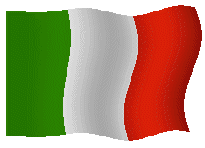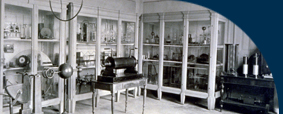 |
Peltier's atmospheric electrometer |
 |
Elettrometro atmosferico di Peltier |
| Subject: meteorology/atmospheric electricity gauge |
Settore: meteorologia/misuratore dell'elettricità atmosferica |
| Number of catalogue:295 |
Numero di inventario: 295 |
| Engraved on the inner base, beside the graduated ring in brass silver-plated: "Secretan à Paris" |
Sulla base interna, lungo l'anello graduato d'ottone argentato: "Secretan à Paris" [inciso] |
| 3/4 of the 19th century |
Periodo di costruzione: 3/4 del XIX secolo |
| Mahogany, brass, glass, steel, paper, silver |
Materiali utilizzati: Mogano, ottone, vetro, acciaio, carta, argento |
124 X 150 X 170 [mm] |
Dimensioni: 124 X 150 X 170 [mm] |
| |
|
Description: The glass cylinder that protects the gauging mechanism is situated in a circular groove on an elegant mahogany square base that is supported by three brass levelling screws. This gauging mechanism is substantially identical to the one described earlier (N°294, Fig. 55). The instrument has two identical scales: one is on a strip of paper along the external wall of the cylinder, and the other is carved on a silvered disk, which is on the internal base of the cylinder. Both scales have two zeros and are divided into four quadrants: each of them is graduated from 0° to 90°. A small brass rod is rigidly positioned at the double zero reading and it must be positioned along the magnetic meridian by rotating the instrument. The needle is cut in half. The conductor that explores the atmospheric electricity is a pair of brass hemispheres on which a long rod with a brass point (now unfortunately lacking) was tightened to the pair of hemispheres according to the design suggested by the physicist and naturalist Horace Bénédict De Saussure (1740-1799). He added a long metal point or a hook to the instrument lid (which was a golden leaf electrometer) so that small metal balls, supported by long conducting wires, could be hung onto it in order to gather electricity from the upper atmospheric layers. In the catalogue of 1874 of the famous French firm Secretan the electrometer was offered at a cost of 100 Francs. |
Descrizione: su una elegante base quadrata in mogano sostenuta da tre viti di livello d' ottone è incastrato, su una scanalatura circolare, il cilindro di vetro che protegge il meccanismo di misura. Questo è sostanzialmente identico a quello descritto nella precedente scheda (vedi N. di inventario 254, fig. 55). Lo strumento ha due scale identiche: l'una su una striscia di carta lungo la parete esterna del cilindro, l'altra incisa su una corona circolare d'ottone argentato posta sulla base interna del cilindro. Esse sono con doppio zero divise in quattro quadranti ciascuno graduato da 0 a 90º. La verghetta d'ottone è rigidamente fissata lungo la linea del doppio zero e va orientata, ruotando lo strumento, lungo il meridiano magnetico. L'ago è per metà spezzato. Il conduttore esploratore dell'elettricità atmosferica è una coppia di emisferi d'ottone sulla quale si avvitava una lunga asta a punta d'ottone (mancante), secondo il «design» proposto dal fisico e naturalista ginevrino Horace Bénédict De Saussure (1740-1799). Questi infatti aggiunse sul cappellotto dello strumento (un elettrometro a foglie d'oro) una lunga punta metallica o un gancio per potervi attaccare dei piccoli palloni metallici, sostenuti da lunghe corde conduttrici, per raccogliere l'elettricità negli strati più alti dell'atmosfera. Nel catalogo del 1874 della rinomata ditta francese Secretan, l'elettrometro veniva offerto al costo di 100 franchi. |
| |
|
| |
Funzionamento: è sostanzialmente identico a quello descritto precedentemente (numero di inventario 294, fig. 55).
|
| |
|
Bibliography: Secretan [1874], p.142; Jamin [1891], tome 4 (2nd Part), file IV, pp. 2-5. |
Bibliografia: Secretan [1874], p. 142; Jamin [1891], Tome 4 (2º partie), fascic. IV, pp. 2-5. |

